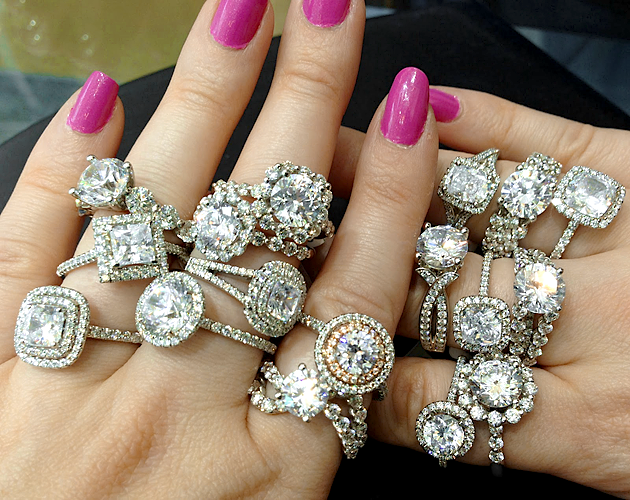SHOP PAY PAYMENT PLANS AVAILABLE. FREE SHIPPING ON YOUR ORDER TODAY!
Guide to Engagement Ring Settings
When it's time to ask that special someone to spend the rest of their life with you, you want to get the best possible engagement ring for them. You may choose to go with a setting style that is classic or something completely modern and unique. Whichever setting you decide on, it will be perfect for your perfect someone.

Prong Setting
Prongs are the most common setting for a diamond solitaire ring. There are between four and six prongs that hold the diamond in place but also allow the light to penetrate the diamond at every angle. This shows off the stone's brilliance and allows it to look larger. Sometimes the head or basket that holds the stone is raised up from the shank in order for it to show importance. A prong setting is the most secure setting for a diamond.

Channel Setting
In a channel setting, the diamond is held in place by two metal strips instead of prongs. Because there are no prongs, this type of setting is smoother and is less likely to snag on clothing or pull hair. The diamond is very secure in the channel setting, and the metal bars also protect the edges of the stone. Used more commonly for wedding bands and anniversary bands, the channel setting is idea for more than one stone in the ring, as a row of diamonds is beautiful in a channel setting.
Bezel Setting
A bezel setting is slightly different than a channel setting because the stone is held in place by a rim of metal that surrounds it like a frame. A bezel setting can completely surround the stone or can only partially surround it. This type of setting protects the stone, so it is a secure setting for a solitaire. It also allows the stone to look slightly bigger.
Tension Setting
Just as the name suggests, the tension setting holds the stone in place by using pressure to secure it in the mounting. This setting allows the stone to look as if it is floating in the ring. It is a more modern style but is a beautiful choice nonetheless.
Bar Setting
The bar setting is very similar to a channel setting but instead uses a bar that is U or V shaped in order to hold the stone in place. It is also used often in wedding bands and anniversary bands. Although it is thought of as being a classic look, the beauty and simplicity is also very contemporary as well.
Illusion Setting
Using a metal plate to hold the stone into the setting, the illusion setting is similar to the prong setting. The plate reflects light and allows the stone to appear larger than it actually is. It is a sophisticated setting that is usually used for princess-cut stones that are set in a group of four to make them appear as one single stone. In this case, the stones are also being held into the setting from the basket below.
Invisible Setting
When there are several stones set together and held in place underneath the setting, this is an invisible setting. It is similar to the illusion setting in that the stones are set closely so that they resemble one continuous stone. There are not prongs or bezels used on top, so the light is able to shine through the entire stone. This setting is great for princess-cut stones.
Cluster Setting
A group of diamonds set closely together is called a cluster setting. The diamonds can be arranged a pattern or in a tight formation. Usually, a cluster setting sits higher on the hand to appear to be a single stone.
Pavé Setting
Pavé-set stones are usually smaller stones that are set in place with tiny prongs or silver beads resembling prongs. They are usually in a formation or a row. The metal underneath the stones is not visible, so it looks as if the band is made entirely of diamonds. The pavé setting is similar to a channel setting, but they are usually smaller stones set with the appearance of prongs.

